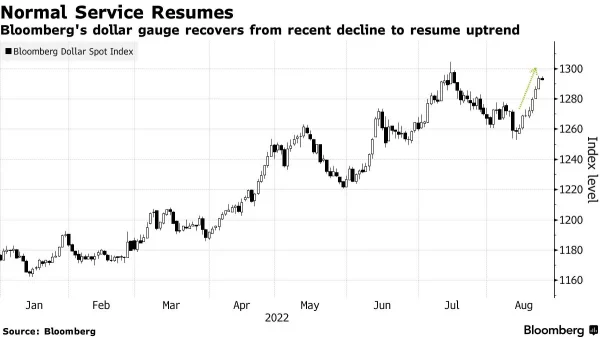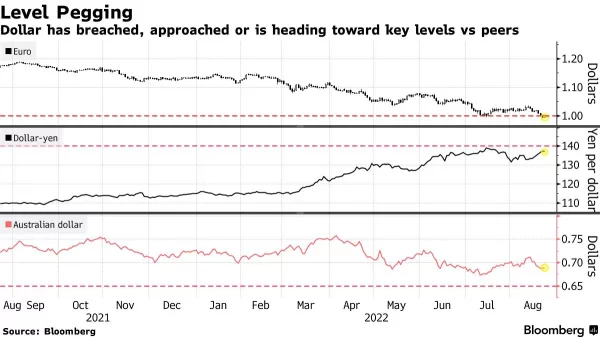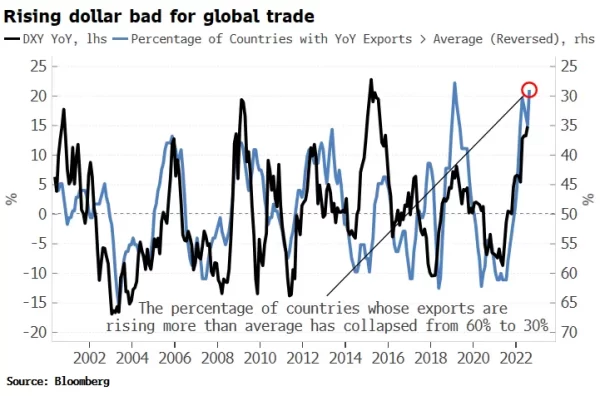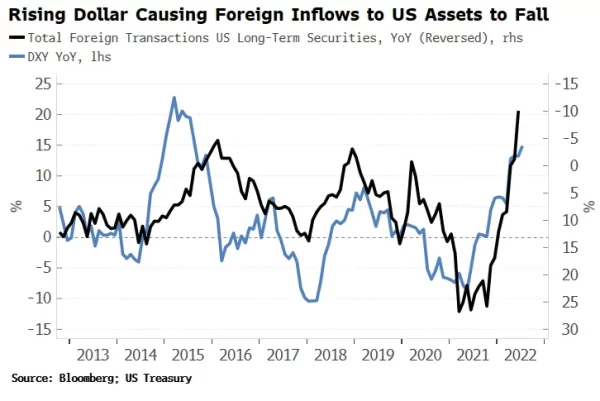Despite a slight decline from its highest levels since 2002, around 109 range, it is just a correction, and the green king, the US dollar, will resume its rally.
On both sides of the dollar’s strength equation, motives exist for it to continue its gains. One is betting on the continued weakness of its major peers, from the faltering European currencies to the weak Japanese Yen, as they suffer from their own problems. On the other hand, the Federal Reserve’s insistence on keeping hiking rates and fear of recession will drive the demand for the dollar. The dollar is a winner in both cases.
Why is the US dollar so strong?
The dollar rose against the world’s major currencies, heading for its biggest rally in nearly 40 years and the third largest since President Richard Nixon broke the dollar’s peg to gold more than half a century ago. Many reasons are contributing to the dollar’s strength since the beginning of the year:
1. The dollar benefits in all cases, whether during periods of outperformance of the US economy or recession. If risks increase, people seek the strongest safe-haven, the dollar. And if the economic outlook for the US flourishes, we see the dollar benefiting from this positive situation.
2. The Fed’s commitment to raising interest rates until inflation returns to its 2% target, even if it will sacrifice some strength in the labor market and slowdown in the US economy.
3. The fear of recession leads to higher demand for the dollar.
4. A widening gap between the hawkish Federal Reserve and other central banks would lead to a stronger dollar.
Why are the major currencies weak?
The rise of the dollar was manifested in the dramatic declines witnessed by the rest of the major currencies:
1. The Euro:
The strength of the US dollar has pushed the euro to parity, the lowest level for the euro since 2002. The euro is unlikely to recover from its lows against the dollar until Europe emerges from the natural gas crisis sweeping the region.
2. Japanese Yen:
Hopes for a JPY recovery have faded, despite Japan’s recent pickup in inflation. The dollar index is moving steadily towards 137 amid renewed interest in buying the dollar. The Bank of Japan’s insistence on holding the ultra-easing policies will increase the yen’s weakness against the dollar.
3. Gold:
The dollar was the main obstacle to gold this summer. If the dollar index is not at 20-year highs, gold will be about $150 higher than current trading levels, according to Wells Fargo.
4. Even the Chinese currency reached its lowest level against the dollar in two years.
Forecasts:
- According to Bloomberg data and JPMorgan forecasts, the euro will fall the most against the dollar by the end of the year, as the single currency will drop to $0.95 by December.
- RBC Capital Markets believes that the British pound will fall more than 5% over the same period to the $1.11 level.
- The Commonwealth Bank of Australia expects the Australian dollar to fall to 65 US cents.
The dollar’s strength is hurting global trade and may hurt it too!
The main driver of global capital flows is trade. Almost all major commodities are traded in US dollars. A higher dollar will eventually result in lower global trade, with the price of everything higher in terms of foreign currencies.
Global trade is faltering, which means capital inflows are declining. The dollar’s recent rally could cause global trade to fall – and thus lower demand for dollar-denominated assets – which could lead to weaker dollar demand.
The rapid appreciation of the dollar is even more harmful to emerging markets, whose central banks collectively move the equivalent of more than $2 billion in foreign reserves every day.
The technical view supports the USD
On the technical side, all indications suggest that the dollar will continue to rise. All larger timeframes (daily/weekly/monthly) are bullish and optimistic, supporting the dollar’s rally.
If the dollar index broke through the pivotal Fibonacci barrier at 109.14 and continued the break, it would be another strong bullish signal.
Buying opportunity
Despite the corrective movement of the dollar, all signs point to a return to the upside. So moments of weakness can be seen as buying opportunities before a possible retest at 109.00 and a potential new visit to 2022 high at 109.29.

















